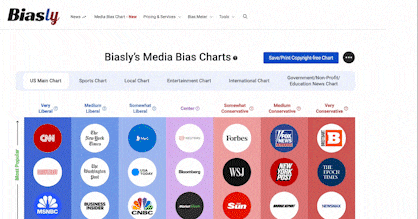The Case Against A Carbon Tax
- Bias Rating
12% Somewhat Conservative
- Reliability
N/AN/A
- Policy Leaning
10% Center
- Politician Portrayal
-3% Negative
Continue For Free
Create your free account to see the in-depth bias analytics and more.
Continue
Continue
By creating an account, you agree to our Terms and Privacy Policy, and subscribe to email updates. Already a member: Log inBias Score Analysis
The A.I. bias rating includes policy and politician portrayal leanings based on the author’s tone found in the article using machine learning. Bias scores are on a scale of -100% to 100% with higher negative scores being more liberal and higher positive scores being more conservative, and 0% being neutral.
Sentiments
N/A
- Liberal
- Conservative
| Sentence | Sentiment | Bias |
|---|---|---|
Unlock this feature by upgrading to the Pro plan. | ||
Reliability Score Analysis
Policy Leaning Analysis
Politician Portrayal Analysis
Bias Meter
Extremely
Liberal
Very
Liberal
Moderately
Liberal
Somewhat Liberal
Center
Somewhat Conservative
Moderately
Conservative
Very
Conservative
Extremely
Conservative
-100%
Liberal
100%
Conservative

Contributing sentiments towards policy:
58% : David was on the Trump presidential transition team at the Environmental Protection Agency in 2017, and previously was a senior research fellow in energy economics and climate change at the Heritage Foundation.57% : Most recently in July, the European Union released a plan to impose a fee on imports of certain products as part of its climate package.
53% : This type of tax will be recognized by students of economics as a Pigouvian tax.
52% : It is a constant battle to keep people that want tariffs and other trade restrictions at bay.
51% : You could imagine the carbon tax proposal being similar to the cap and trade proposal, where they looked at oil and petroleum refiners, taxing the refiners, taxing natural gas producers, and taxing coal at the mine mouth.
48% : Setting the level of tax for a potential carbon tax is one of the major questions that policymakers would have to confront in designing any new tax.
47% : Since the first carbon taxes were introduced in the 1990s, there's been slow but steady growth in the number of taxes introduced around the world.
46% : As far as the design options go, the main pieces that Congress would have to decide include the rate of tax on emissions, which is an area where there's a lot of debate because where the tax rate is set changes the impact on emissions, as well as the total revenues that would be raised.
41% : Finland, Poland, Norway, Sweden, Denmark, the Netherlands, and Germany all introduced taxes on carbon in the 1990s.
39% : That uncertainty could also be a potential argument for starting with a lower rate of tax.
39% : It's very, very difficult to get rid of tariffs because of what we call the special interests effect.
*Our bias meter rating uses data science including sentiment analysis, machine learning and our proprietary algorithm for determining biases in news articles. Bias scores are on a scale of -100% to 100% with higher negative scores being more liberal and higher positive scores being more conservative, and 0% being neutral. The rating is an independent analysis and is not affiliated nor sponsored by the news source or any other organization.

























 Forbes
Forbes